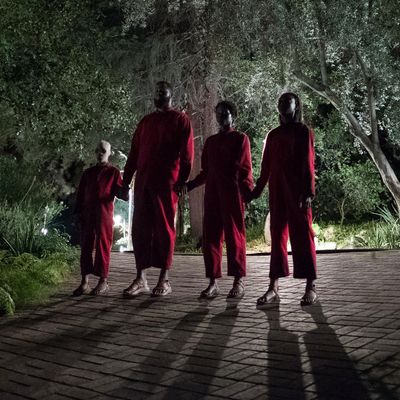
In the weeks leading up to the release of Us, Jordan Peele’s much-anticipated follow-up to Get Out, I checked its Wikipedia page daily for the plot summary. When it finally switched over from a few vague teaser sentences to a full play-by-play, I read it excitedly, thought damn, that sounds scary, and closed out of the tab with zero plans to ever see it for myself.
That’s also how I “watched” Hereditary, The Babadook, all eight Saw movies, and pretty much every popular horror film released over the past several decades. (I truly can’t wait for the Midsommar entry.) My favorite? The Mothman Prophecies, which is about a sexy, emotionally wounded Richard Gere being haunted by a giant, spooky mothman. This phenomenon of the faint of heart reading horror movie Wikipedia pages instead of viewing them the normal way has been well-documented recently, by Rob Harvilla at the Ringer, Jaya Saxena at GQ — who, brave soul that she is, actually watches the films afterward — and others. But — besides the fact that I’m a busy woman on the go who simply doesn’t have time to be overcome with anxiety about being haunted by a demonically possessed doll, and also an enormous wuss who hates witnessing bodily harm of any kind — why am I, and possibly you, doing this?
I called up Margee Kerr, a sociologist who studies fear and the author of Scream: Chilling Adventures in the Science of Fear, to learn more. Kerr explained that, in general, horror movies can act as a “confidence boost” of sorts. “By watching horror movies, we can get close to danger without actually being threatened and gain a sense of control or knowledge or at least a sense of mastery over something that we hope to never encounter in real life,” she said.
People who actually enjoy horror movies, she explained, tend to be more open to new experiences. The people who don’t “are stress-sensitive, have a higher need for control, and are uncomfortable with uncertainty.” In my scientific sample size of one (me), that checks out.
But some of us who fall in the latter category are still capable of channeling the pleasurable experiences that come with watching a horror movie — or at least staying in the loop as horror movies become more of a part of the cultural conversation — by reading these entries. “Sometimes people need a little bit more of a protective frame. So instead of watching a horror movie, reading it can feel a lot less scary because it’s more in the person’s control. They’re reading the Wikipedia page and they have total control over when they can stop reading,” Kerr said. “And it doesn’t have all of the other effects that definitely ramp up our sympathetic nervous system: sound effects, lighting effects, the changes in the emotional voices in the characters.”
The Wikipedia pages are also uniquely suited to those who really can’t even handle reading tense or frightening stories. Whereas a horror novel or scary story can build up suspense and truly frighten, plot summaries tend to be almost laughably cut-and-dry — as straightforward as it gets. (For instance, from the entry for Us: “At the beach, Jason wanders off and sees a man in a red jumpsuit standing alone on the beach with bloodied hands and his arms outstretched. He does not tell his family about the man but later draws a picture of him.”) “It’s kind of like listening to NPR vs. CNN,” Kerr said of the textual differences. “You get it a little more stripped away from the emotion and that can be more accessible to people who are interested in the story line.”
Dr. Steven Schlozman, a psychiatrist and horror writer himself, said that novels can often be even more fright-inducing than horror films. “You’re going to be a lot more unsettled because it’s your brain creating the images. The screen image usually can’t hold a candle to what our own brain can come up,” he explained. “By definition, [the Wikipedia summary] removes imagination. The ‘well, what if this happened to me?’ thing is not a question that’s being actively asked, because there’s no story that’s being pushed forward there.” Take my favorite page, for instance, which includes just enough eerie details to make me feel the dullest of adrenaline rushes — “This episode starts a string of supernatural calls to John’s motel room” — without actually elucidating exactly what’s so terrifying — “He meets an expert on the subject, Alexander Leek, who explains its nature and discourages John from becoming further involved.”
Kerr herself will often read the pages before she goes to the theater, so she knows what she’s signing up for and can avoid anything she thinks is especially troubling. My colleague Callie Beusman, who usually only watches horror films at home when “hungover and subconsciously looking to increase my suffering,” even pulls up the Wikipedia page for a movie while simultaneously viewing it. “If I decide to watch one (mistake),” she told me, “I will do it during so I get less scared.” For the rest of us who’ll never make it to a screening or hit play, may I recommend some excellent Wikipedia pages instead?





